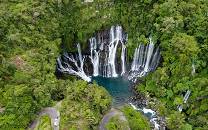Réunion juts out of the ocean, and nowhere else do mountains of this size merge with the sea. The dramatic scenery is dominated by the accessible Piton de la Fournaise (2,632m/8,635ft), one of the most active volcanoes in the world. The island is hemmed by black volcanic and white sandy beaches, but it’s the outdoor activities that attract most visitors.

-
Rates (USD)
- $0 to $0 pp/day
-
Best Time To Go
- May to November (Less rain)
-
High Season
- July, August, Christmas, Easter (Busy)
-
Size
- 2,512km² / 970mi²


Pros & Cons
- Beautiful scenery
- Active volcano
- Hiking, mountain biking and horseback riding available
- Water sports offered
- Lots of marine wildlife
- Mixed Creole/French culture
- Beaches are less idyllic than on other islands
- Little English spoken
Weather & Climate
Réunion’s climate varies depending on altitude. The coast has a hot, tropical climate, while up in the mountains it is more temperate. The wet, hot summer lasts from December to April, while May to November sees drier and cooler conditions. Cyclones may occur from January to March.
More about the weather and climate
Best Time To Visit
Réunion can be visited at any time. Hikers often prefer the dry, cooler months of winter (May to November). Whales migrate to the waters of Réunion around this time too (June to October). If you prefer hotter weather, you might like to come in the rainy summer months (December to April), but perhaps stay away from January to March, which is cyclone season.
More about the best time to visit

